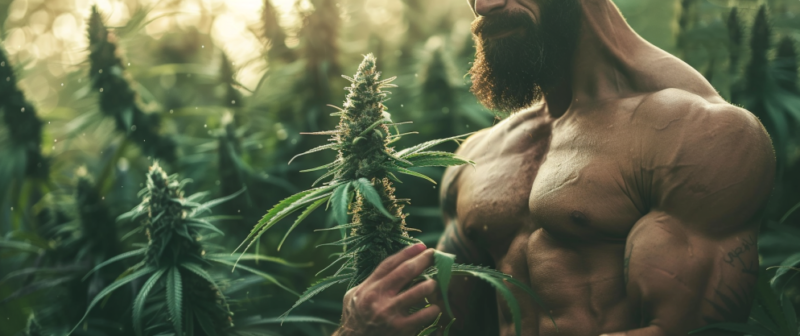What Is Delta 8 Made Out Of
Delta-8-tetrahydrocannabinol is a cannabinoid derived from the cannabis plant, known for its milder psychoactive effects compared to Delta-9 THC. Understanding its composition involves exploring the natural and synthetic processes used to produce it.
What is Delta 8 made out of? By looking into the origins and production methods of Delta-8 THC, consumers and researchers can gain a clearer insight into this intriguing compound and its place within the broader landscape of cannabis-derived products.
What is Delta 8?
Delta 8 is a cannabinoid compound found in the cannabis plant, known for its psychoactive effects but milder than Delta 9 tetrahydrocannabinol (THC).
Related Post:
How Long Till Delta 8 Leaves Your System (Plus Detox Tips)
What Happens If You Take Too Much Delta 8?
Originating from the same molecular structure as Delta 9 THC, Delta 8 is created through a process of isomerization which converts CBD into this unique compound. This cannabinoid exhibits distinct properties, including offering a clear-headed high and reputed medicinal benefits.
In terms of classification, Delta 8 belongs to the tetrahydrocannabinol family, sharing similarities with its well-known sibling Delta 9 THC, while setting itself apart through its slightly lesser potency and its potential to produce a more tolerable experience for some users.
What is Delta 8 Made Out Of?
Delta 8 is primarily derived from hemp plants through chemical synthesis or extraction methods, in compliance with the regulations outlined in the Agriculture Improvement Act of 2018.
In terms of extraction, one common method involves utilizing solvents like ethanol or CO2 to isolate Delta 8 from the hemp plant. This process not only requires precision but also adheres to strict safety protocols to ensure the purity of the final product.
On the other hand, the synthesis method involves chemically converting CBD, another compound found in hemp, into Delta 8 through controlled reactions. This intricate process demands a deep understanding of organic chemistry and meticulous attention to detail.
Legal considerations play a significant role in the manufacturing of Delta 8. Companies must navigate through a complex web of regulations to ensure compliance with the law, which includes testing for THC content to meet the legal threshold set by authorities such as the Food and Drug Administration.
What is the Chemical Composition of Delta 8?
The chemical composition of Delta 8 involves a specific arrangement of atoms and bonds, resulting in a unique isomeric form within the cannabinoid family.
What sets Delta 8 apart from its close relative, Delta 9 THC, is the location of a double bond in the molecular structure. In Delta 8, this bond is found on the 8th carbon chain, hence the name.
This distinction impacts the interaction of Delta 8 with the body’s endocannabinoid system, leading to milder psychoactive effects compared to Delta 9. The unique positioning of this bond also influences the stability and longevity of Delta 8 products, making them desirable for various applications.
What is the Source of Delta 8?
The primary source of Delta 8 is the cannabis plant, specifically derived from hemp varieties cultivated for industrial and agricultural purposes.
In terms of the botanical origins of Delta 8, it all starts with hemp plants, which have been prized for their versatile uses for centuries. Hemp, a strain of cannabis sativa, is predominantly grown for its fibers, seeds, and now, its high Delta 8 content.
The cultivation practices associated with producing Delta 8 involve careful monitoring of the plant’s growth stages to ensure optimal cannabinoid levels. Farmers employ sustainable agricultural methods, including organic fertilizers and pest control measures, to yield potent and pure Delta 8 extracts from these specialized hemp plants.
How is Delta 8 Extracted?
Delta 8 is extracted from hemp plants using various methods such as solvent extraction, distillation, or chromatography techniques in specialized laboratory settings.
In terms of solvent extraction, it involves the use of solvents like ethanol or hydrocarbons to isolate Delta 8 from the hemp plant material. During distillation, the hemp extract is heated to separate compounds based on their boiling points, with Delta 8 being collected at the desired temperature.
Chromatography techniques, on the other hand, separate compounds through differential adsorption and elution processes, allowing for precise isolation of Delta 8.
What are the Key Components of Delta 8?
The key components of Delta 8 include its interactions with cannabinoid receptors in the brain, influencing various physiological processes and cognitive functions.
Delta 8 acts as a partial agonist to the CB1 and CB2 receptors, subtly altering the endocannabinoid system’s signaling pathways.
With its unique structure, Delta 8 exhibits binding affinities that distinguish it from its more renowned counterpart, Delta 9 THC. This distinction allows for a milder psychotropic effect, offering users a potential alternative for those seeking a more balanced and less intense experience.
The neural impact of Delta 8 extends beyond receptor interactions, as it also influences neurotransmitter release and uptake, contributing to its potential neuroprotective and anxiolytic properties. Researchers are delving deeper into these mechanisms to unveil the full spectrum of Delta 8’s effects on brain functions and overall well-being.
What is the Role of Delta 8 in Cannabis Plants?
In cannabis plants, Delta 8 serves a unique role in the production of terpenes and secondary metabolites, contributing to the plant’s aroma, flavor, and protective properties.
Terpenes are organic compounds responsible for the distinct scents and flavors of cannabis strains. Delta 8 plays a crucial part in terpene synthesis, influencing the specific aroma profile of each plant.
These terpenes are not only significant for their sensory qualities but also act as natural defenses against pests and pathogens, helping the plant thrive in its natural environment.
The chemical significance of Delta 8 extends beyond terpene production. It interacts with various enzymes and receptors within the plant, modulating essential metabolic processes and signaling pathways that contribute to overall plant health and resilience.
Is Delta 8 Safe to Consume?
The safety of Delta 8 consumption for disease is a topic of ongoing research, with studies investigating potential adverse effects, toxicity profiles, contamination, and long-term implications.
Research and advertising has highlighted the importance of understanding the agent’s impact on various bodily systems, including the central nervous system. It is crucial to grapple with the health risks associated with its consumption, such as potential impairment of cognitive functions and coordination.
Studies have looked into the potential toxicity levels of Delta 8, shedding light on its effects on vital organs like the liver and heart. Regulatory bodies are scrutinizing the market closely, aiming to establish guidelines to safeguard public health.
Make sure to keep in touch with a Poison Control Center to learn important information and prevent any adverse event.
What are the Potential Side Effects of Delta 8?
Potential side effects of Delta 8 may include nausea, vomiting, and stress, although individual responses to this cannabinoid compound can vary.
Some individuals consuming Delta 8 may also experience dizziness, dry mouth, or increased heart rate. These side effects are typically mild and temporary, subsiding as the compound metabolizes in the body.
It is important to note that certain risk factors, such as pre-existing medical conditions or sensitivity to cannabinoids, can amplify these adverse reactions. Clinical considerations suggest starting with a low dosage of Delta 8 to gauge tolerance levels and gradually increasing intake if needed.
Psychologically, Delta 8 may induce euphoria, relaxation, or altered perception of time and space. Excessive consumption can lead to feelings of paranoia, confusion, or disorientation, especially in individuals with a history of mental health issues.
Is Delta 8 Legal?
The legal status of Delta 8 varies by jurisdiction, with regulations enforced by authorities such as the Drug Enforcement Administration (DEA) and local legislative bodies.
At the federal level, Delta 8 is classified as a Schedule I controlled substance under the Controlled Substances Act, despite being derived from hemp. This classification poses challenges for producers, distributors, and consumers given the restrictions on its production and distribution.
Upon deeper research on the internet, some states have taken a more lenient approach, legalizing Delta 8 within their borders under specific conditions and regulations.
How is Delta 8 Used?
Delta 8 is commonly used in various forms such as tinctures, edibles, or topicals, with dosages tailored to individual needs for potential medicine therapy.
In terms of administration methods, Delta 8 can be ingested orally through tinctures or edibles, allowing for easy and discreet consumption. Topicals offer localized relief when applied directly to the skin, making them particularly effective for targeting specific areas of discomfort.
Dosing guidelines for Delta 8 typically depend on factors like body weight, tolerance levels, and the desired therapeutic effects. A gradual approach is often recommended to determine the optimal dosage that provides maximum benefits with minimal side effects.
What Forms Does Delta 8 Come In?
Delta 8 is available in diverse product forms, including candies, chocolates, beverages, vapes, and oils, catering to consumer preferences and medicinal needs.
Consumers seeking a discreet and tasty option may opt for Delta 8-infused candies and chocolates, offering a sweet and easy way to enjoy the benefits of this cannabinoid.
For those preferring a drinkable form, Delta 8 beverages such as teas or sodas provide a refreshing and convenient choice.
Vaping enthusiasts can find a range of Delta 8 vape products tailored to different flavors and strengths.
Delta 8 oils offer a versatile and customizable method of consumption, allowing users to control dosage and potency with precision.
What is the Recommended Dosage of Delta 8?
Much like in other compounds like alcohol, the recommended dosage of Delta 8 depends on factors like body weight, tolerance, and desired effects, with considerations for appetite stimulation, relaxation, and sleep enhancement.
When determining the ideal dosage of Delta 8, it is essential to start low and gradually increase to find personal optimal levels. Starting with 5-10mg is common for beginners to assess tolerance and effects.
For those seeking appetite stimulation or relaxation, a slightly higher dose may be necessary, typically in the range of 10-20mg. On the other hand, individuals using Delta 8 for sleep enhancement may benefit from a dose closer to 20-40mg.
Final Thoughts – What Is Delta 8 Made Out Of
Delta-8-tetrahydrocannabinol is a unique cannabinoid primarily derived from hemp plants through processes like chemical synthesis and extraction.
Understanding what Delta-8 is made of involves examining its origins, the chemical conversion methods used to produce it from cannabidiol (CBD), and its distinct chemical composition compared to other cannabinoids.
As interest in Delta-8 THC continues to grow, a thorough understanding of its production and characteristics becomes essential for both consumers and researchers getting the evolving landscape of cannabinoid science.
FAQ
1. Is delta 8 made from hemp or marijuana?
Delta 8 can be derived from both hemp and marijuana plants. However, it is typically found in higher concentrations in hemp plants, making it a more common source for extraction.
2. Is delta 8 a natural or synthetic compound?
Delta 8 can be found naturally in cannabis plants, but it can also be created synthetically in a laboratory. Synthetic delta 8 is chemically identical to its natural counterpart.
3. Can delta 8 be used in food or drinks?
Yes, delta 8 can be infused into food and drinks in the same way as other cannabinoids like CBD or delta 9 THC. However, it is important to note that delta 8 may have different effects and dosing than other cannabinoids, so it is important to consume with caution.


